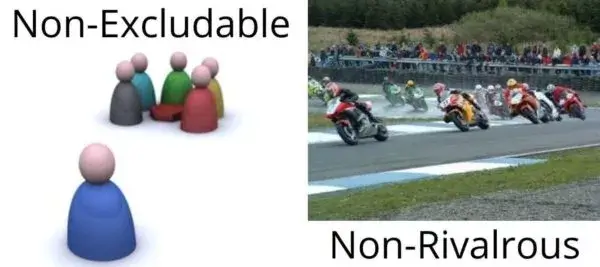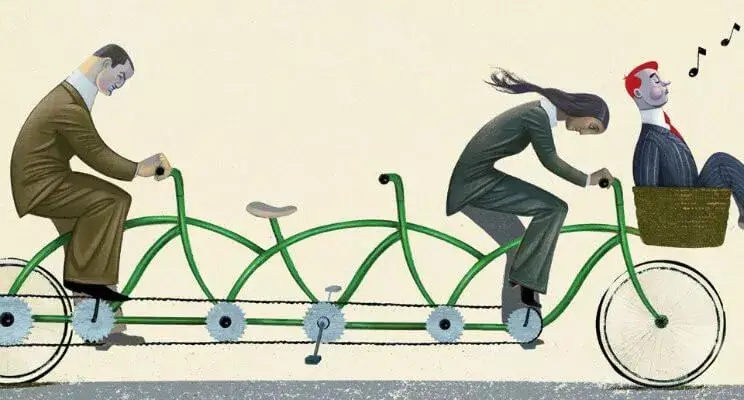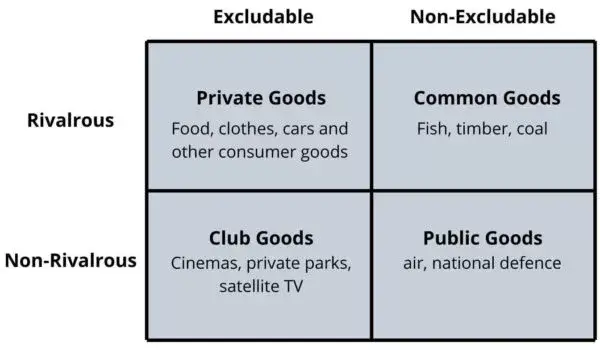Why Are Many Of The Services That Governments Provide Called Public Goods?
WRITTEN BY PAUL BOYCE | Updated 23 March 2021
A public good is a good whereby no individual tin can exist excluded from benefiting from information technology. In other words, everyone can do good from its utilize. This could come up in the form of a regime public good such as pedagogy, or a natural public good such as air.
One of the key aspects of a public skilful is the fact that anyone tin use information technology, just it doesn't diminish its availability. For instance, one person can use a public streetlamp, nonetheless it doesn't diminish the ability for someone else to as well use it.
Public goods are almost always funded publicly through the government. Perhaps the only public goods that aren't, are natural appurtenances such equally air, the sun, and such.
- A public practiced is a expert that government provides which is both not-excludable and non-rivalrous.
- Examples of public appurtenances include – defence force, policing, streelights, and lighthouses.
- Governments oftentimes seek to provide public goods when in that location is a market failure.
Public goods have ii key characteristics – non-rivalry and non-excludability. Non-rivalry ways that more than 1 person tin use the good without diminishing others ability to use it. In that location is also non-excludability, which refers to the inability to restrict other consumers from using the good.

Non-excludability means that the producer of the good is unable to prevent others from using it. For example, it would exist extremely difficult to foreclose each person from using a traffic light. Doing so would require extreme levels of management and prevent the utilise of certain roads.
At the same time, non-excludability means customers cannot be directly charged. If we wait again at traffic lights, information technology would be hard but also chaotic to put in place a system whereby each user pays. Then non merely is it virtually impossible to prevent utilise but also collect payment.
Public goods such as defence force, policing, and the police force are all non-excludable. Everyone benefits from policing, which makes it impossible to charge some but not others. In plow, this presents us with the 'gratis-rider problem'.
Equally public goods are not-excludable, everyone has access to them. Every bit a outcome, we accept what is known as the 'gratuitous-rider problem', which ways that people benefit from the good without contributing to its payment.
The issue with the gratuitous-rider trouble stems from the fact that if certain individuals are not paying, then the rest will too be reluctant to pay. In plough, a individual firm would produce fewer of such goods, resulting in a sub-optimal supply to society. Therefore, the solution would exist for the government to pay for it from general taxation.

With public goods, the initial and subsequent costs are by and large borne by the taxpayer. As a outcome, it is the taxpayer who bears the toll whilst others tin do good without paying for information technology.
The free-passenger problem is considered a market failure considering people are benefiting, yet non paying for the good. As a result, this can lead to an overuse of public goods. For instance, policing and the police force are usually overstretched beyond their means.
With regards to public appurtenances, non-rivalry ways that other consumers are non excluded based on others consumption. In other words, merely considering Barry is using the streetlight does not mean that Susan is unable to.
Non-rivalry is ofttimes forgotten when looking at public appurtenances. For instance, many will mistakenly consider universal healthcare as a public skillful. Whilst at that place is nothing to stop all citizens accessing it, in that location is a rivalrous component.
To explain, the more than people who take up a bed in a hospital, the fewer at that place are for other patients. Similarly, the more than doctors' appointments taken, the fewer there is available for anybody else.
There is a level of confusion that surrounds public goods. It may meet sure criteria to an extent but does non meet the two characteristics. These can be separate down into 4 singled-out categories: private goods, common goods, club goods, and public goods.

Private goods are those that are both excludable and rivalrous. In other words, people tin can be prevented from benefiting from the product. At the same fourth dimension, the more one person consumes, the less there is bachelor to others.
Such examples include: electronics, nutrient, clothing, piece of furniture, and about consumer appurtenances.
Common goods are those that are non-excludable, but rivalrous. In other words, consumers cannot exist stopped from benefiting from the adept. However, it is rivalrous, which means that some may be excluded due to the consumption of others.
Such examples include: fish stocks, coal, timber, and other natural resource.
Guild appurtenances are those that are excludable, simply non-rivalrous. In other words, a private business firm is able to forbid people who do non paying from using information technology. Yet its increased consumption does not prevent others from accessing it.
Such examples include: Boob tube, parks, and magazine subscriptions.
Public goods are those that are both non-excludable and non-rivalrous. IN other words, the supplier cannot prevent people from using the good, nor volition its consumption foreclose others from accessing it.
Such examples include: defence, policing, and streetlights.
When at that place is a market failure, it is argued that governments should step in to provide public goods. For case, if private companies are unable or unwilling to provide a good, then the government should footstep in. The reason for such is that public goods create a greater social do good than the individual cost.
For case, anybody may be willing to spend $1 per month for policing. However, when measured collectively, this figure tends to increase. Consumers will value a public good more highly in the knowledge that others are as well paying for it. As a consequence, the social value is said to be maximized when provided for by the public.
There are usually market failures with public appurtenances because private entities are unwilling or unable to supply the socially optimal amount to the market. For case, there is no company or rational mode by which a individual business firm would provide defece to a nation.
Peradventure some contractors could supply function of the market, just defence is oft a large employer in almost nations – particularly the US. This is known as a marketplace failure because a private business firm is unable to see the necessary demand required. Therefore, the regime steps in to provide the public expert and overcome this market failure.
The consequence with public goods is that it brings value to individuals who have not paid for the goods, which comes under the 'gratuitous-rider' trouble.
So whilst it may create social benefits, it comes at a greater cost to some. For case, social club may value the goods more highly, but this actress value is borne by involuntary revenue enhancement.
If we look at defense force, for example, some concord with having a large military, and some don't. By increasing the size of the military, jobs are created, and it tin can be argued that greater social value is created through more sophisticated defence systems. However, it is completely involuntary, and the minority must submit to the wishes of the majority.
The very nature of public appurtenances comes nether the assumption that the social value is greater than the private cost. However, this assumption is not e'er accurate. After all, information technology is impossible to gauge the social benefit to the millions of taxpayers. Do they truly value the construction of a new local park to melody the of $5 million? Does that social do good exceed the toll? That is a question that is only answered past elected officials instead of the consumer.
Public goods must be both non-excludable and non-rivalrous. This is often overlooked when claiming certain appurtenances to exist 'public goods'. For instance, healthcare is oftentimes classified every bit a public expert, besides as roads, tunnels, and bridges. However, they are all appurtenances than can easily exclude others.
For case, price roads can preclude the use of roads if there is no payment. These are known as 'Quasi-public goods', which we will look at in the adjacent section.
- Make clean Air
- Defense
- Lighthouses
- Public Park
- Streetlamps

Let us first look at some examples of public goods.
A public good that is non actually provided for by private or public organisations. Air is a natural element, although clean air is costless from pollution and is not-excludable.
It is everywhere on globe, so it is non-excludable to anyone. At the same fourth dimension, air is so plentiful that its consumption does not foreclose anyone else's.
Non-excludable in the fact that a nation tin can provide defence, even so everyone can benefit. Many will disagree or concur on the importance of defence spending, merely it is impossible to exclude people from war machine protection (skillful or bad).
Information technology is also non-rivalrous in the fact that defense is not actually consumable. In other words, one person cannot eat a level of defence. It is universal and not-consumable – making it a public skilful.
One of the classic examples of public goods. It is non-excludable in the fact that information technology would be hard to forestall ships from sailing by and benefiting.
At the aforementioned time, information technology is non-rivalrous in that many ships can use the lighthouse at the same time without diminishing others ability to use it.
Another example of a public practiced is the public park. It is both non-excludable in the fact that everyone has admission to the park, but besides not-rivalrous as ane consumer does not restrict the ability of another to savor the public skillful.
It is near impossible to exclude people form making use of streetlamp at night. Information technology is also incommunicable to obtain payment from each and everyone that uses it.
Furthermore, streetlamp are as non-rivalrous. Ane person continuing under a streetlamp does no prevent someone else walking by from benefiting from the light.
Quasi-public goods are a sort of hybrid between private appurtenances and public goods. They take characteristics of both. For example, they are partially excludable, and are partially rivalrous. Some of these goods include roads, tunnels, the net, and TV.

Whilst such goods are normally non-excludable, there are toll roads, pay-to-admission websites, and premium cablevision TV. All of them require payment to access and tin easily and profitably exclude people.
Quasi-public goods are sometimes considered public goods because private businesses may be unwilling or unable to fulfil the nations demand.
For instance, private companies may be able to construct new roads and implement tolls. Withal, they are unlikely to exist able to exercise this on a national scale.
Private goods and public goods are complete opposites. Whilst public goods are non-rivalrous and non-excludable, individual goods are rivalrous and excludable. In other words, public appurtenances are unable to exclude people.
By contrast, a private good tin exclude people from its utilize, commonly in a budgetary fashion. For instance, you have to pay to get into the movie theatre.
The cinema prevents those without a ticket from getting into the theatre. Past contrast, there is no feasible way of doing this. That, or information technology would be incredibly expensive to do then.
Public Goods = Non-rivalrous and Non-excludable
Private Goods = Rivalrous and Excludable
At the same fourth dimension, private appurtenances are rivalrous. In other words, the more one person consumers, the less at that place is for others. For instance, there is but a limited quantity of cakes in a baker at any one fourth dimension. And so the more customers that purchase doughnuts the fewer are bachelor to others.
What are examples of public appurtenances?
Some examples of public goods include: defence, lighthouses, streetlamps, and clean air. They are all non-excludable and non-rivalrous every bit divers past public practiced.
What is the public appurtenances problem?
The public goods trouble arises from the 'free-passenger' phenomenon. This is caused by people benefiting from the public good, but not contributing to its expense.
What is an instance of a quasi public good?
Quasi public goods are appurtenances that are partially rivarlous and partially excludable. Still, they exercise non come nether the classificaiton of a private or a public proficient. Rather, information technology is somewhere in between.
Such examples of quasi public goods include: roads, television, and the cyberspace.
Is education a public good?
Education is not a public skillful because it is excludable, and to an extent, rivalrous. It is excludable in the fact that schools are able to pass up applicants based on their location. Or, in private schools, based on their ability to pay. So students can exist excluded, and therefore education cannot be classified equally a public good.
Furthermore, it tin also be considered rivalrous. With only 30 places available, the more students that make full up the spaces, the fewer in that location are bachelor to someone else.
Further Reading
Why Are Many Of The Services That Governments Provide Called Public Goods?,
Source: https://boycewire.com/public-goods-definition-and-examples/
Posted by: owensvibody.blogspot.com


0 Response to "Why Are Many Of The Services That Governments Provide Called Public Goods?"
Post a Comment